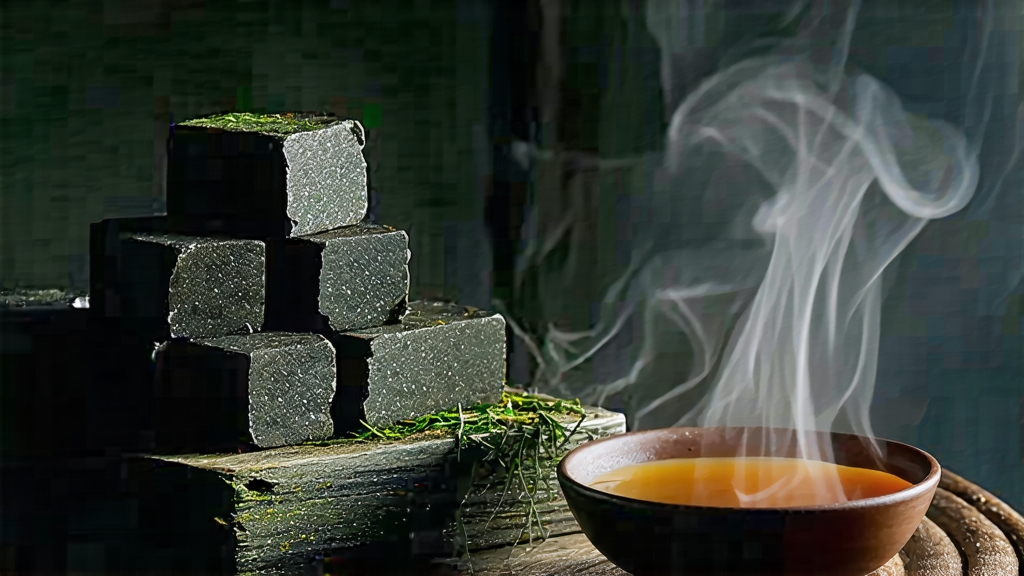
Tucked beneath the humid karst hills of Guangxi, Liupu tea sleeps in man-made caves where the air tastes of wet stone and river mist. To the uninitiated it looks like a forgotten relic—compressed bricks wrapped in frayed bamboo, surfaces mottled by golden spores of Eurotium cristatum. Yet when the brick is pried apart the aroma rises like memory: damp camphor, dried longan, and something faintly reminiscent of betel nut, the signature scent that once perfumed the trading docks of Wuzhou. Liupu is the least famous of China’s dark teas, overshadowed by the Pu-erh juggernaut, but within its velvet liquor lies a story of Ming dynasty soldiers, Qing dynasty pirates, and twentieth-century bankers who used tea bricks as underground currency.
The name itself is a cartographic ghost. During the Qing, “Liupu” designated a small river port six li (three kilometres) upstream from Wuzhou’s main wharf. Jute sacks of raw tea were off-loaded there, carried by porters singing three-note work songs, then reloaded onto bamboo rafts that drifted down the Xun River to Guangzhou and, eventually, to the tea-hungry Chinatowns of San Francisco. When the port silted up in the 1920s the name migrated to the tea, anchoring it forever to a place that no longer exists.
Liupu belongs to the “hou fajiao” family—post-fermented teas whose chemistry is rewritten by microbes after the leaves have been killed-green. The cultivar is a large-leaf Camellia sinensis var. assamica transplanted from Yunnan in the 16th century, but the terroir has bent its genetics: Guangxi’s acidic red soil, high rainfall, and sub-tropical fog produce leaves that are thicker yet more porous than their Yunnanese cousins. Farmers pluck one bud with three or four leaves in late April, when the spring rains pause and the sun flickers like a faulty lantern. The harvest window lasts only ten days; any later and the monsoon dilutes the leaf’s sugars, robbing the tea of its future honeyed note.
Withering happens on the second floor of stilt houses where bamboo slats allow smoke from the kitchen hearth to drift upward. The leaves lose 30 % of their moisture in six hours, curling like antique parchment while absorbing trace aromas of camphor wood and rice broth. Next comes “sha qing” (kill-green) in a wok heated to 280 °C. The tea master uses a rhythmic pressing motion—palm down, fingers curled—to bruise the leaf edges just enough to rupture cell walls without shredding the lamina. The moment the leaf’s grassy note vanishes and is replaced by the scent of roasted chestnut, the batch is flung onto rattan trays to cool.
What distinguishes Liupu from other dark teas is its double piling phase. The semi-dry leaves are heaped 40 cm deep in pine-lined chambers where humidity hovers at 85 %. Thermophilic bacteria raise the pile’s core to 55 °C within four hours; the tea master inserts a bamboo pole fitted with a thermometer every thirty minutes, turning the pile when the mercury threatens to climb past 60 °C. Over the next twelve days the leaves darken from moss green to the colour of bitter chocolate, while Eurotium cristatum—known locally as “golden flower”—blooms in microscopic constellations. The first piling ends when the leaf’s moisture drops to 20 %; the second begins after a forty-eight-hour rest, this time in thinner layers to encourage slower oxidative reactions that generate the tea’s signature betel-nut aldehyde.
Compression follows ancient ergonomics. A square steel frame is lined with steamed bamboo leaves; seven pounds of fermented leaf are tamped down with a 10-kilogram stone hammer swung in a figure-eight pattern. The hammer’s head is carved from basalt dredged out of the Xun River, its pores impregnated with centuries of tea oils that impart an imperceptible seasoning to every new brick. The brick is wrapped in reed matting, tied with rattan, and carried—still warm—to the caves.
These caves are not natural grottoes but quarries abandoned after limestone was extracted to build the city’s colonial banks. Inside, temperature stays between 18 and 22 °C year-round; relative humidity is locked at 75 % by underground springs that drip in slow Morse code. Bricks are stacked in herringbone aisles, leaving